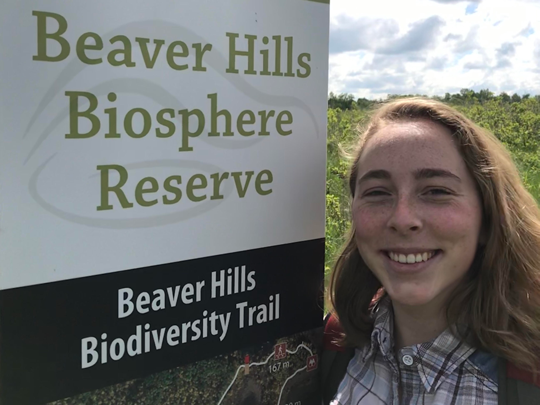Biosphere Stories: Listening to People and the Land

Linnea Bell, Masters research student at the University of Alberta, holds a deep connection to the Beaver Hills Biosphere (BHB). In this article Linnea discusses her current research project that aims to tell the story of the BHB and the deep cultural connection many have to this special place.
As part of a team of University of Alberta researchers who have partnered with the Beaver Hills Biosphere, and with MITACs support, Linnea Bell is working with supervisor, Dr. PearlAnn Reichwein, to conduct oral history interviews and archival research within the Beaver Hills.
Her research project, titled Biosphere Stories: Sharing an Environmental History of People and Places in the Beaver Hills, will delve into and gather different perspectives of what the landscape means to various stakeholders, as told through stories of people and place. Information for the project will be documented through archival reviews, oral history interviews, field work and social gatherings.
“We want to share and record knowledge, memories and stories that community members have gained while living, working or playing within the Beaver Hills region,” explains Linnea.
The project is intended to understand why the Beaver Hills are important to the people who have spent time in the region, now and in the past. Linnea’s research aims to identify what makes the Beaver Hills special to those who have spent time there and determine what is important for future generations to know about the region and life on the land now designated a UNESCO biosphere reserve. Ultimately, Linnea’s research goal will also help people learn how biodiversity has supported us and in turn understand how to support the biosphere.
In Her Words: Linnea’s Story
My mother’s parents immigrated to Canada in 1968, settling in Edmonton at first to attend the University of Alberta. Within a few years, however, they chose to move to the country with their two children to have a big garden, chickens, geese, and a small flock of sheep. Both grandparents were also very interested in geology, ecology, plants and soils, and living in the Beaver Hills area suited the family perfectly.
My grandmother came from a rural background and was particularly eager to share this same experience with her daughters. Some years later, as a student at Colchester Elementary School in Strathcona County, my mother conducted an environmental study on her family's forty-acre farm as part of a school project. She observed the various ponds, puddles, and bodies of water and in her report concluded that, “Our farm does not have any dangerous fish!”
My grandfather went on to become a professor at the University of Alberta always retaining his interest in teaching others about the local landscape. My grandmother also continued to work in the area as a researcher of textiles, with some of her work being on historic fur farms of the area.
I was raised on the stories of the experiences of my family’s life on the land in the Beaver Hills. My life was enriched hearing about the way my mother’s dog would kiss the noses of the neighbour’s cows, how another family’s horse would lie down and refuse to walk when the kids wanted to ride, how my grandmother’s garden yielded raspberry preserves, and about my grandfather teaching university students how to sample soil cores at Elk Island National Park.
I am currently working towards my master’s degree in history within the Faculty of Kinesiology, Sport, and Recreation at the University of Alberta and I began my research as a historian with a bachelor’s degree in History from Mount Allison University, New Brunswick.
Share Your Story
Linnea looks forward to getting to know the Beaver Hills through other’s memories, experiences and perspectives. If you are interested in sharing your stories please contact her at bell1@ualberta.ca.